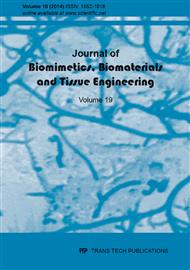p.13
p.25
p.35
p.43
p.65
p.77
p.87
p.99
p.109
Effects of Cell Density on Mechanical Properties of Alginate Hydrogel Tissue Scaffolds
Abstract:
Cell-seeded hydrogel scaffolds have been widely used in various tissue engineering applications due to their excellent biocompatibility and biomimetic properties. One of the critical issues in successful use of hydrogel scaffolds is their mechanical properties. Since cells and hydrogels are physically different materials, the cells encapsulated in the hydrogels can change profoundly the mechanical properties of the hydrogel scaffolds. In this research, the effects of Schwann cell density on mechanical properties of alginate hydrogel scaffolds were investigated. It was found that increase of cell density decreases the strength of the scaffolds. It was also found that the Ogden model can best describe the mechanical properties of the scaffolds under the strain of 45% at varying cell densities. Based on the cell density-dependant mechanical properties, a simulation was performed to study the local stresses of on cells when cells are subjected to loading. Simulation shows that at the same strain, the stress concentration on cells decreases as the cell density increases. The experimental and simulation results obtained in this paper will allow one to rigorously design scaffolds with desired mechanical properties and provide a clue to avoid mechanical cell injury.
Info:
Periodical:
Pages:
77-85
Citation:
Online since:
March 2014
Authors:
Keywords:
Price:
Сopyright:
© 2014 Trans Tech Publications Ltd. All Rights Reserved
Share:
Citation:


